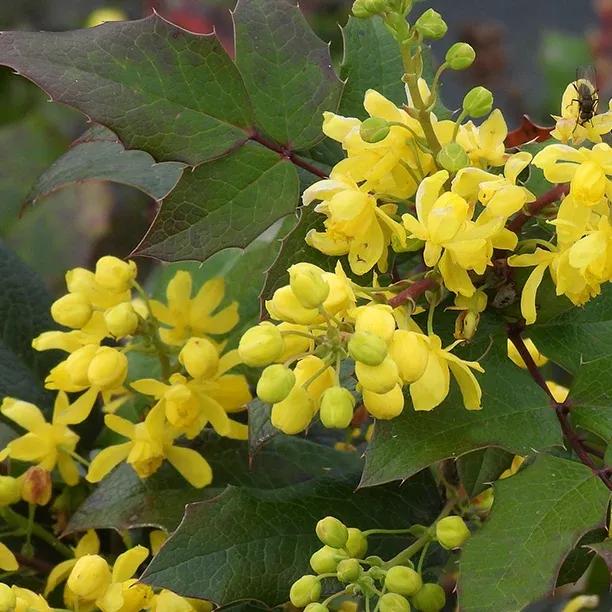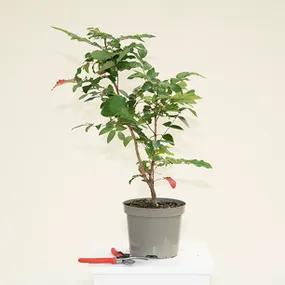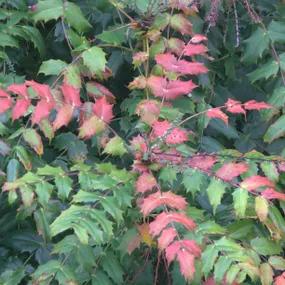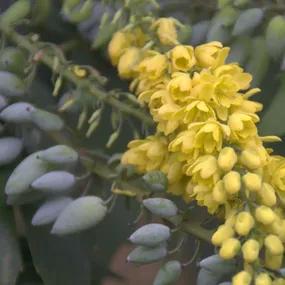Oregon Grape Hedge Plants
Honest Delivery PricesMahonia aquifolium
Shrubs- Evergreen, suckering shrub.
- Yellow flowers in late winter.
- Purple berries.
- Any well drained soil. Shade-tolerant.
- Used as informal low screening.
- Requires shelter from wind.
- Max Height 3m
- RHS Plants for Pollinators
- Bareroot Delivery: Nov-Mar
- Pot GrownB Delivery: Year Round
Description
Mahonia Aquifolium Bushes
Delivered by Mail Order Direct from our Nursery with a Year Guarantee
Mahonia aquifolium, Oregon Grape, is a winter flowering evergreen plant that can be used as an informal, thicket-type of hedge, although it isn't suitable for neatly clipped, formal hedging.
It will grow in any well drained soil and it tolerates shade.
It can be grown as a screening shrub up to about 3 metres high.
Note: Mahonia's one weakness is the wind, which will damage the beautiful foliage. It should be planted in sheltered locations, and grows well under deciduous trees.
Oregon Grape plants are delivered bareroot, during winter (Nov-March), and pot grown year round.
All of our young trees and shrubs are measured by their height in centimetres above the ground (the roots aren't measured).
View our selection of coastal hedging plants or see our full range of hedging.
- Evergreen, suckering shrub.
- Yellow flowers in late winter.
- Purple berries.
- Any well drained soil. Shade-tolerant.
- Used as informal low screening.
- Requires shelter from wind or else leaves get tattered.
- Max Height 3 metres.
- RHS Plants for Pollinators
- Bareroot Delivery: Nov-Mar
- Pot Grown Delivery: Year Round
Spacing a Mahonia aquifolium hedge/screen:
Mahonia makes an attractive, solid row of screening plants with a rough, wild look to them.
Plant it at 2 plants per metre, with 50cm between each plant.
For a really bushy hedge, we suggest interplanting Mahonia with Berberis darwinii.
General description of Oregon Grape plants:
Mahonia is a very useful evergreen for bringing colour to your garden. It has profuse yellow flowers in late winter and spring that mature into blue-black berries. Both the flowers and fruit are edible, although the berries contain lots of seeds and not very much flesh, so they aren't going to be anyone's favorite. The spiky, glossy green leaves are similar to holly, and although they are evergreen, they change colour to deep red in autumn.
Mahonia is a suckering shrub, producing new stems from ground level and, over time, producing a small thicket.
Did You Know?
This North American shrub was introduced to Britain in the 1890's and can now be found growing wild in many areas.
You can harvest the flowers and infuse them with water to make a refreshing drink, and the ripe berries can be used to make jam or cooked with some sugar.
Planting Instructions
Notes on planting Mahonia aquifolium:
This hardy plant will grow in any well drained soil, including chalk. It can grow on fertile sites near the coast, but it won't do well on very poor, dry, sandy soil. It is shade tolerant and can be grown underneath large trees.
Mahonia is a tough plant, but it tends to look quite sad when it grows in exposed sites with dry soil. It generally looks best when it is grown in a sheltered location.
Prepare your site before planting:
It is good to dig over the area where you intend to plant several months in advance. Destroy the weeds first: nettles, brambles and ground elder are tough. Then dig the soil over; remove rocks, roots and other rubbish. Mix in well rotted compost or manure down to the depth of about 2 spades.
If you have a heavy clay soil, it might be too difficult to dig over for most of the year. Heavy clay is fertile soil, so you don't really need to improve it; killing the weeds is still necessary.
Remember to water establishing plants during dry weather for at least a year after planting.
Planting accessories:
Prepare your site for planting by killing the weeds and grass.
If you are planting in an area with rabbit and/or deer, you will need to use a protective plastic spiral for each plant, supported by a bamboo cane.
If your soil quality is poor, we recommend using mycorrhizal "friendly fungi" on the roots of new trees and shrubs.
You can also improve your soil with bonemeal organic fertiliser.
After Care
After you plant your Mahonia aquifolium plants, the most important thing to do is water them in dry weather. You will also need to weed around the plants. Both of these will be necessary for at least a year after planting.
Water thoroughly but not too often: let the soil get close to drying out before watering your plants again.
Like all evergreen plants, Mahonia aquifolium is active and needs moisture in the ground throughout the year. This means that your establishing plants need to be watered in the winter when they are planted, if the weather is dry.
Notes on pruning & caring for Mahonia aquifolium:
Once they have established, they will look their best if you cut back one or two stems every year down to about 30cm high. This will make the plants more dense, bushy and keep them producing lots of flowers.
The best time to cut back your Mahonia is in spring, after the flowers fade.
If you need to renovate the whole plant, you can cut down to stumps about 30cm high, or to cut back just the biggest stems, leaving the thinnest, youngest stems to provide cover while the rest of the plant grows back.
Hygiene & Diseases:
Dead, damaged or diseased wood can be pruned off as soon as it appears.
Disinfect your pruning tools between every cut if there is any sign of disease.
Burn or dispose of any diseased material, do not compost it.
After you plant your Mahonia aquifolium plants, the most important thing to do is water them in dry weather. You will also need to weed around the plants. Both of these will be necessary for at least a year after planting.
Water thoroughly but not too often: let the soil get close to drying out before watering your plants again.
Like all evergreen plants, Mahonia aquifolium is active and needs moisture in the ground throughout the year. This means that your establishing plants need to be watered in the winter when they are planted, if the weather is dry.
Notes on pruning & caring for Mahonia aquifolium:
Once they have established, Oregon grape plants will look their best when they are periodically cut down to stumps. This will make the plants more dense, bushy and keep them producing lots of flowers.
The best time to cut back your Mahonia is in spring, after the flowers fade.
It's up to you whether to cut the whole plant down to stumps about 30cm high, or to cut back just the biggest stems, leaving the thinnest, youngest stems to provide cover while the rest of the plant grows back.
Hygiene & Diseases:
Dead, damaged or diseased wood can be pruned off as soon as it appears.
Disinfect your pruning tools between every cut if there is any sign of disease.
Burn or dispose of any diseased material, do not compost it.





